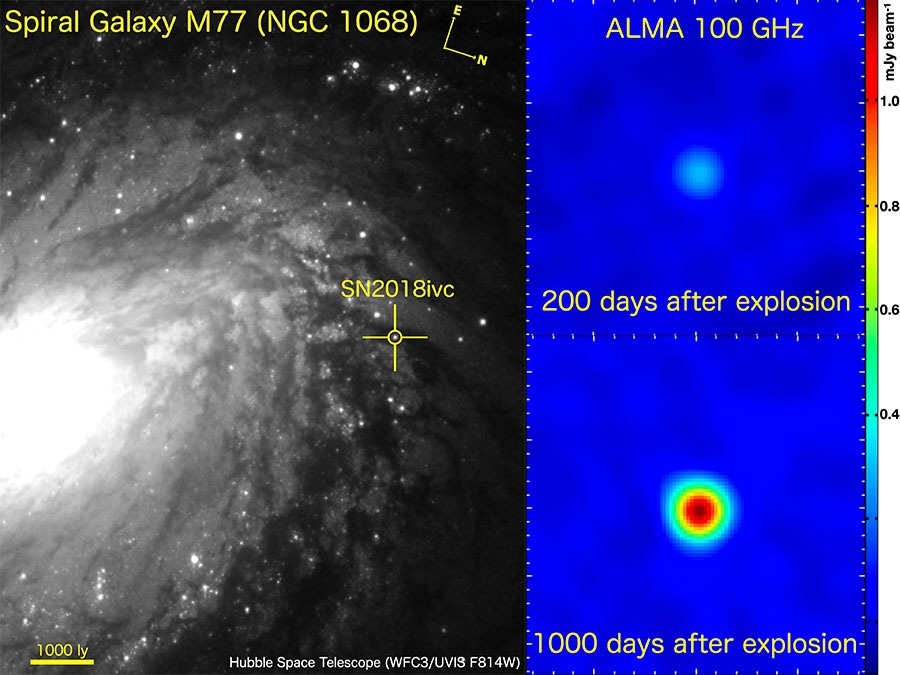A supernova displaying unparalleled rebrightening at millimeter wavelengths has been found by astronomers. This observation offers an intermediate link between two kinds of supernovae: close-binary systems and solitary stars.
 An image of the central region of M77 taken by the Hubble space telescope (left), in which the position of SN 2018ivc is marked. Right panels show the expanded view around SN 2018ivc based on the data taken by ALMA, at ~200 days (upper right) and ~ 1000 days (lower right), clearly showing that the rebrightening happened at about one year after the SN explosion. Image Credit: (left) Based on observations made with the NASA/ESA Hubble Space Telescope, and obtained from the Hubble Legacy Archive, which is a collaboration between the Space Telescope Science Institute (STScI/NASA), the Space Telescope European Coordinating Facility (ST-ECF/ESA) and the Canadian Astronomy Data Centre (CADC/NRC/CSA). (right) ALMA (ESO/NAOJ/NRAO), K. Maeda et al.
An image of the central region of M77 taken by the Hubble space telescope (left), in which the position of SN 2018ivc is marked. Right panels show the expanded view around SN 2018ivc based on the data taken by ALMA, at ~200 days (upper right) and ~ 1000 days (lower right), clearly showing that the rebrightening happened at about one year after the SN explosion. Image Credit: (left) Based on observations made with the NASA/ESA Hubble Space Telescope, and obtained from the Hubble Legacy Archive, which is a collaboration between the Space Telescope Science Institute (STScI/NASA), the Space Telescope European Coordinating Facility (ST-ECF/ESA) and the Canadian Astronomy Data Centre (CADC/NRC/CSA). (right) ALMA (ESO/NAOJ/NRAO), K. Maeda et al.
The end of life for several massive stars results in a catastrophic explosion called a supernova (SN). Supernovae increase quickly in brightness and then fade over the course of many months.
For a long time, astronomers have been aware of the fact that the evolution of massive stars can be impacted by the presence or absence of a close binary companion. In a close binary system, gravitational interactions alongside the binary companion will strip huge amounts of material from the SN progenitor long before the eventual explosion.
In such cases, the progenitor will be quiet till the time of the actual SN. Besides, in the case of an SN progenitor with no binary companion or a diverse companion, resulting in the SN explosion, the progenitor will keep the majority of its initial mass.
Of course, smart alecs will question, “What happens when the binary is not too close and not too distant?” Not just smart alecs, astronomers also wished to know.
The break came when a global research group, headed by Keiichi Maeda (Professor at the Graduate School of Science, Kyoto University) and Tomonari Michiyama (ALMA Joint Postdoctoral Fellow at the Graduate School of Science, Osaka University), made use of ALMA (The Atacama Large Millimeter/submillimeter Array) to track a supernova called SN 2018ivc as it dimmed for around 200 days following the initial explosion.
The outcomes displayed that SN 2018ivc was a strange object, so the teamdecided to checkp on it again, nearly 1000 days after the explosion. They discovered that the object was really rebrightening, the first time this phenomenon had ever been noted in millimeter wavelength radiation.
Comparison to numerical modeling indicates that the interaction with an intermediate-distance binary companion around 1500 years before the SN explosion made a huge hollow shell of the circumstellar medium.
At 200 days following the SN, the ejecta flying out from the explosion had yet to reach the shell. Further, sometime between 200 and 1000 days, the ejecta made a collision with the circumstellar medium.
Journal Reference:
Maeda, K., et al. (2023) Resurrection of Type IIL Supernova 2018ivc: Implications for a Binary Evolution Sequence Connecting Hydrogen-rich and Hydrogen-poor Progenitors. The Astrophysical Journal Letters. doi.org/10.3847/2041-8213/acb25e.